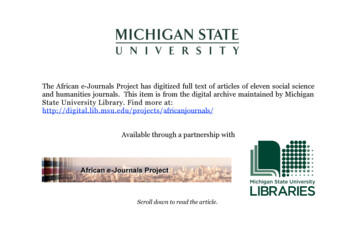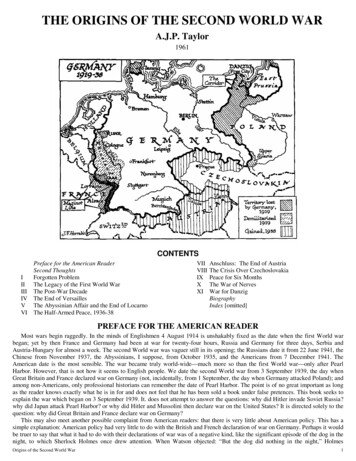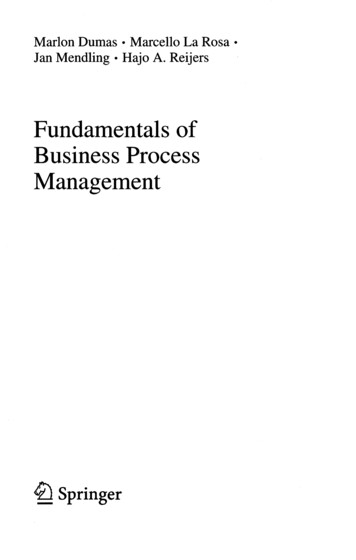
Transcription
The African e-Journals Project has digitized full text of articles of eleven social scienceand humanities journals. This item is from the digital archive maintained by MichiganState University Library. Find more nals/Available through a partnership withScroll down to read the article.
Origins of the TswanaL. NgcongcoThe Tswana chiefdoms form part of the largergroup of Sotho peoples, while the Sotho group itself isone of the three great sub-divisions of the Bantuspeaking peoples situated north of the Nguni. 1 Inaddition to the Batswana or 'Western Sotho', the Sothogroup includes the Basotho of Lesotho and the Orange FreeState, to whom the term 'Sotho' has come to be more specifically and almost eXClusively applied.This group some-times also is referred to as the 'Southern Sotho'.Athird group comprises the Bapedi who have been generallyreferred to as the 'Northern Sotho,.2These different Sotho groups that togethermay be more conveniently described as 'Sotho-Tswana' atthe very earliest stage of their history, shared a numberof linguistic and cultural characteristics that distinguished them from other Bantu-speakers of southern Africa.These are features such as totemism, a pre-emptive rightof men to marry their maternal cousins, and an architectural style characterised by a round hut with a conicalthatch roof supported by wooden pillars on the outside.3Other minor distinguiShing features included their dressof skin cloaks or dikobo and breech-cloths,4 a variety ofBuispoort-type pottery closely related to Schofield'sNC2 variety,5 and a predilection for dense and close6settlements, as well as a tradition of large-scalebuilding in stone.?21
While the Sotho-Tswana developed these distinguishing characteristics, they did, of course, alsoshare a number of characteristics with other southernBantu-speaking peoples.These included physical featureswhich generally speaking, make it hard to distinguishSotho or Tswana from Xhosa, Zulu or Swazi; although manyTswana, especially those living south of the Molopo tendto be of a lighter complexion than others, as well asbeing slightly lankier with prominent cheek-bones - features which clearly point to considerable inter-marriageand other forms of interaction with such groups as theKhoi, Koranna and Griqua.8The languages of the Sotho-Tswana and other Bantu-speakers have a number of commonfeatures - they are agglutinative in construction, nearlyall the words ending in vowels or with a nasal consonant,nouns do not indicate masculine or feminine gender, andthese nouns are highly alliterative in character owing toan elaborate system of noun classes functioning in muchthe same way that gender does in European languages.Also, there are similarities in idiom which are not easyto express in a precise manner.9Among the cultural affinities shared by thesouthern Bantu-speakers are their lineage descent systems.All these groups are patrilineal - a factor which is oftremendous importance to the pattern of succession andtherefore to both dynastic and filial generations.Theyall practised polygamy, observed the levirate or sororateforms of marriage, gave bridal cattle on marrying theirwives, and in varying degrees, observed the age-set organisation.There are also indications that at one timeall these groups practised circumcision.lOThe traditions of the Sotho-Tswana peoplepoint to a northward origin, and indicate that theirsouthward movement was part of the great migrations of theBantu-speaking iron-age peoples.Early Sotho people havebeen associated with the B.l culture that is thought tohave flourished between the Zambezi and the Limpopo, andwere also thought to have developed the gold trade with
Sofala. According to L.Fouch this is also attested byevidence from pottery remains, and the Sotho period terminated when the early Shena invasion entered theZambezi-Limpopo area about A.D. 1200.11 Although thedirection from which the Sotho and other Bantu-speakerscame is readily accepted by all writers, there must beconsiderable reservation about locating the place oforigin of these groups in either Egypt or Ethiopia.12Other indications favouring the theory ofnorthward origins of the ancestors of the Sotho-Tswanapeoples are linguistic features, pottery styles and theirarchitecture.Malcolm Guthrie has pointed out that thereare indications that such languages as Sotho, Venda andNguni have developed from Zezuru, which is a Shonalanguage.If this view was tenable, it would imply aconsiderable period of close settlement, or at any event,a very intimate association over a long time among thespeakers of those languages.l3 However, a close readingof the writings of Christopher Ehret gives the impressionthat save for Venda, he questions the gist of the Guthriethesis with respect to the development of languages likeSotho and Nguni which formed elements of a protoSoutheast Bantu network.l4 His general conclusion isthat the sub-Zambezi languages, which were part of the'Pembela complex' could be divided into two groups namely Shona and Southeast Bantu, and that what these twogroups share in language they also share with other Bantulanguages north of the Zambezi.Consequently 'any commonperiod in their linguistic histories would have to beattributed to historical events outside southeasternAfrica.15D. P. Abraham who conducted extensive oralresearch among societies of Rhodesia added to the evidenceconfirming the north dorigins Sotho-Tswana peoples byreferring to a period of close interaction between suchearly Sotho groups as the Bafokeng and the Barolong andRhodesian peoples.This is thought to have taken placein the Guruuswa district of Rhodesia.l6 Again JohnSchofieldhas drawn attention to typological analogues
of the ceramic wares of the Iron Age B.l culture with thatof the Sotho-Tswana.It is striking, however, thatSummers' discussion of the Rhodesian Iron Age B.l culturecarefully refrains from any specific correlation ofSotho-Tswana and Rhodesian societies on the basis ofpottery styles, while Inskeep warns against the dangersof attempting to identify ethnic groupings on the basisof pottery assemblages, especially when the samples ofpottery examined have been so few.This is, of cours, atypical example of the frustration that the student ofhistory encounters so frequently in his quest for thehistorical conspectus amidst the plethora of esoteric andpredominantly typological writings of archeologists.Thearcheologist is quite prepared to describe materialculture but reluctant to ascribe it to the ancestors ofany particular ethnic or linguistic group.A problem flowing directly from that of theorigins of the Sotho-Tswana concerns the chronology oftheir arrival in southern Africa.For a long time writtentraditions have repeated the theory that the Sotho-Tswanaor at least the Tswana, arrived in South Africa in asuccession of migration waves, and speculations about thetime of their arrival have been inextricably bound upwith this 'wave theory' of immigration.Usually thetheory asserts that the Sotho-Tswana separated from otherBantu-speaking peoples in the vicinity of the Great Lakesof East Africa, and that they proceeded downwards alongthe western part of present-day Rhodesia in three seriesof migrations.l?The first wave is accordingly thought to havecomprised such groups as the Dighoja, the Bathammaga,Batsatsing and other early groups simply known asBakgalagadi, who settled in parts of the Transvaal Highveld, the eastern portion of Botswana and of the northernCape Colony, where they intermingled freely with thepre-existing Khoi and San communities.The second waveis said to have brought the ancestors of the Bafokeng,Barolong and Batlhaping societies who settled along the
upper reaches of the Molopo spreading south and west fromthe neighbourhood.The third and largest migration isalleged to have comprised the other major Sotho-Tswanagroups whose descendants have survived as the present-daysocieties of Botswana, Lesotho, the Transvaal, OrangeFree State and the northern Cape in South Africa.Accord-ing to this 'wave theory' each group of immigrants intoSouth Africa subdued or conquered groups that precededit in the area of settlement.Implied in this 'wave theory' is the notionthat by the time the Sotho-Tswana crossed the Limpopothey were already ethnically well-defined and fullydifferentiated into the modern chiefdoms we know today;and that many Sotho-Tswana chiefdoms can be traced backto a far distant past ante-dating their migration intoSouth Africa.Another misleading impression conveyed isthat of large-scale migrations that originated hundredsor even thousands of miles from the vicinity of theequatorial lakes keeping together as ethnically homogeneous groups that invaded the sub-Limpopo area conqueringpre-existing, smaller and probably non-iron using peoples.This is, of course, hardly tenable.Several scholarshave questioned, and through their researches, discreditedthis popular myth of mass migrations, and have demonstrated that where these have occured at all, they havebeen a rare phenomenon.18 With reference to the SothoTswana as well, it would be far more realistic to thinkof their earliest migrations in terms of small-scalescattered movements of several segmentary lineage groupsoccuring slowly and gradually in many directions over awide area.While during the later stages of the tencenturies preceding 1500 A.D., there may have been a fewancient but well-recognisable Sotho-Tswana groups such asthe Bafokeng and, perhaps, the Barolong, it seems fairlyplausible to think of the appearance of most of the SothoTswana peoples we know today as the result of a slow butsteady process of mingling of several segmentary groups
sharing a number of cultural features. Some groupsprobably increased their numerical size through beingjoined by other small migrant groups.Many of the groupsvere probably mixed and Sotho-Tswana culture wouldaccordingly be a blend of many cultural traits thatdeveloped over a long time in some cradle-land.Theincrease in the size of the Sotho-Tswana population likevise ought to be regarded as having taken place in situthrough the absorption of other groups in the sub-Limpoporegion.Monica Wilson has argued convincingly thatpatrilineal and polygynous lineages with traditions ofexchanging cattle during marriage tend quickly to increaseboth their numerical strengths as groups and their wealthin stock at the expense of those without cattle.19In this connection it is interesting thatboth the Sotho-Tsvana and the Nguni emphasized patrilineage in their marriages.This, together with theSotho-Tswana practice of preferential marriages - apractice encapsulated in the proverb, Ngwana rrangwane,nnyale. dikgomo di boele sakeng: 'Child of my father'syounger brother, marry me, so that the (bogadi) cattlemay return to our kraal,20 - would have the effect ofkeeping wealth in the same lineages, thereby perpetuatingtheir preferred positions.The suggestion made here is that proto-SothoTswana lineages moved very slowly into the sub-Limpoporegion - a process that took several centuries and duringvhich they slowly difussed a 'Sotho-Tswana' culture overgroups they found in that region.It also seems fair toconclude that whatever the linguisticand cultural foun-dation they brought with them, the developments that havegiyen rise to the distinctive language and culture of theSotho-Tswana probably occured in the cradle area or'homeland' lying immediately south of the Limpopo area.2lSuch a hypothesis - of scattered proto-SothoTswana lineages dispersed over a wide area between theLimpopo and the Vaal rivers and the eastern limits of theKgalagadi desert - would also help to account for the factthat many Batswana believe firmly in the creation myth of26
the 'cave of Lowe' at Matsieng not far from Motshodi.22There must have been Sotho-Tswana or a proto-Sotho-Tswanapopulation that dwelt in the vicinity long enough for thelegend to gain currency and be widely diffused that theyand other humans originated there.When it is alsoremembered that the earliest Iron-Age dates for theTransvaal go back to the fifth century A.D., the presenceof iron-using, cattle-keeping and mining peoples in thatregion becomes highly significant.This will be so evenif we do not assume, in a facile manner, that the firstiron-workers in South Africa were Bantu-speakers.23Turning more specifically to the question ofchronology we may begin by considering the archeologicaltestimony, insofar as it is intelligible to the nonarcheologically trained student of history.The areabetween the Limpopo and the Vaal was penetrated by ironusing peoples from about the middle of the fifth centuryA.D.By the eighth century, some of these people weremining copper at Phalaborwa and by the eleventh, smeltingmetal at Melville Koppies.Two Iron-Age cultures have been identified bythe Transvaal's leading Iron-Age archeologist, Revil Mason.These cultures have been named Uitkomst and Buispoort fromthetypesites representing those cultures.Uitkomstsites have been found to be concentrated in the centralpart of the southern Transvaal, around the source of theOdi (Crocodile) river near Tshwane or modern Pretoria.Radio-carbon dating has yielded two dates, A.D. 1060 forMelville Koppies and A.D. 1650 for the Uitkomst caveoccurrence.The Uitkomst culture was an extension of theRhodesian Leopard's Kopje culture which dates from theeighth to the fifteenth centuries.Buispoort culturesites which have a much higher density, occur mainly inthe vicinity of the Rustenburg and Zeerust districts,that is, in the area to which the traditions of the SothoTswana point as their centre of dispersion.The firstdate for the Buispoort culture was about A.D. 13'0 butrecent work by the archeologists in Johannesburg hasresulted in a fifth century A.D. date for the 'Buispoort'site o.fBroederstroom 24/73.2427
In a recent re-evaluation of recorded traditions of the Sotho-Tswana, Martin Legassick has suggesteda geographical identification of the Buispoort culturecomplex with the Kwena-Hurutshe cluster of lineages, andthe Uitkomst complex with the Kgatla or what will here betermed Kgatla-Pedi cluster.25 Mason is confident thatthe site Broederstroom 24/73 represents the earliestrelatively complete settlement known to date in SouthernAfrica.The date of A.D. c.460 for that site brings theradio carbon dates for the cradle-land of the Tswana intoline with that of Castle Peak in Swaziland, for which a26fourth to fifth century date was recently announced.Mason has further reported a date for theearliest Iron-Age penetration of South Africa.This wasfrom a site at Silver Leaves in the districts of Tzaneen,in the northern Transvaal, where charcoal samples yielded27dates such as A.D. 270, A.D. 330 and A.D. 1100.Thesedates have the significance of bringing the chronology ofthe Transvaal into line with that of Rhodesian and Zambiansocieties.The possible links with societies north of theLimpopo are not indicated by chronology alone, but alsoceramW typological analogues, which suggest influences orassociations with first millenium Iron-Age communities inMalawi, Zambia and possibly Kenya.28 Finally, Iron-Ageresearch in the predominantly Tswana populated region ofMagaliesberg-Witwatersrand appears to have made greatstrides since 1971 and to have yielded such an abundanceof data and radio-carbon dates, that the sequences are nowbeing schematically presented in three stages.The EarlyIron-Age dates from A.D. 460 to A.D. 1000, the middle IronAge from A.D. 100 to A.D. 1500/1600 and the Late IronAge dating from about A.D. 1550 to A.D. 1820.29As far as the traditions of the Sotho-Tswanaare concerned, we find we have to deal with severalclusters of chiefdoms.The most important are theFokeng-Dighoya, Rolong-Tlhaping, Kwena-Hurutshe andKgatla-Pedi clusters.sequentially.These may be briefly consideredThe antiquity of the Bafokeng cluster is
widely attested.Their traditions are, however, confusedand incoherent, and render it extremely difficult toreconstruct their royal genealogy and thereby find asound basis for working out their chronology.Consequen-tly, the student of Bafokeng history is bound to leanheavily on the works of such writers as Stow, Theal andEllenberger whose pioneering and sometimes laudablesyntheses of the traditions of the Sotho-Tswana tend tobe vitiated by their proneness to a priori assumptions.30Ellenberger states that the Bafokeng crossedthe Zambezi during the eleventh or twelfth century.Foran indeterminate period they dwelt together with theBahurutshe and the Barolong, for says Ellenberger, thereis a tradition that tells of the separation of theBafokeng and the Barolong at the same time and place asthe separation of Bafokeng and Bahurutshe.31 When theyleft their neighbours - the Barolong and the Bahurutshe at a place that Ellenberger described as 'Bechuanaland',the Bafokeng migrated eastwards to the vicinity of theMagaliesberg range, named after Mogale.This is statedto have occurred before the start of the sixteenthcentury.The sanguinary conflict that is supposed to havegiven rise to this migration is alleged to have been oversome young bulls that the 'Bahurutshe' wished to castratecontrary to the wishes of the Bafokeng.32In the Magaliesberg area, the Bafokeng aresaid to have split into two sections.One of theseremained in the Magaliesberg area, and in the nineteenthcentury suffered much from Mandebele raids.The o ersection further subdivided into a number of clans whichmigrated southwards across the Vaal, thereby becoming thefirst Sotho-Tswana to cross that river.33Some of thesesettled near the hill Ntsuanatsatsi between modern FreeState towns of Frankfort and Vrede, well before the year1530.34At Ntsuanatsatsi the Bafokeng intermingled andintermarried with various San and half-caste groups foundin the vicinity.Tradition states that it was such amarriage by the Bafokeng chief, Napo, at Ntsuanatsatsi
which led to a serious civil strife.When the chief diedthe sons of his San wife were denied recognition as legitimate heirs, a situation that resulted in the disgruntledSan-Fokeng sons of the late chief Napo hiving off.Theymigrated with their followers across the Drakensbergmountains and down along the Natal coast.Their migra-tion route is marked by the type of pottery classified byJohn Schofield as Natal Coast pottery,35HC.2, whichbears a strong resemblance to early Bafokeng pottery foundin the Orange Free State and Lesotho.36 These Bafokengba-'Hutla, literally 'the Bafokeng of the hare', whosetotem was the hare, lived for a short period among theHpondo people along the Transkei coast before moving downfurther south and settling for some time, among theThembu society as the Ama-Yundle clan.3? It is thoughtthat Hpondo and Thembu pottery styles bearing very closeaffinities to Fokeng pottery were a result of thisinteraction.This migration of the Bafokeng-ba-'Mutla fromNtsuanatsatsi has been dated to about A.D. 1600 byEllenberger, but Schofield dated their settlement inNatal towards the middle of the sixteenth century.Walton is of the opinion that Schofield's chronology forthis group is nearer the mark because the Ama-Yundletraditions confirm that they lived in the Transkei forabout eight to nine generations.38Fagan, however, castsdoubt on the dependability of conclusions based on suchslender or tenuous evidence, as well as on the groundsthat the NC pottery had not been dated.39Then there are the corbelled stone hut settlements found widely distributed over the Sotho-Tswana area.As had once been the case with the Zimbabwe ruins, therehas been much discussion about whether these were indeedbuilt by ancestors of the people who lived in that areain this case the Sotho-Tswana.Walton demonstrated fromthe pattern of the cave dwellings at Ntlokholo in Lesothothat the stone villages were the work of the Bafokeng, orpeople influenced by the way of living of the Bafokeng.40Since the radio-carbon date for these settlements is
about 1445-1495,it tends somewhatEllenberger'sestimateNtsuanatsatsiand other high-veldbut does not support'Mutla sojournto supportthat the Bafokenghis estimatein Natal,settlementsites predatesatA.D. 1500,of the Bafokeng-ba-for which A.D. 1600 appearstoolate a date.A pre-1500Ntsuanatsatsidate for Bafokengis in harmonywith the traditionwere found there by the Lesothoclans.to have migratedthe latterofthat theyline or branchAs will be seen later,supposedoccupationof Kwenaclans arefrom the Kwena dispersioncentrein the Limpopo-Odi-Madikwemiddleof the fifteenthwatershedaboutthecentury.When we turn to the Barolong-Batlhapingcluster,clusterwe find that the chiefdomscomprisethe variousbelongingBarolongchiefdomsthe sons of Tau - namelythe eleka,Maribafound byBarolong-andBarolong-- as well as the Batlhaping-PhuduhutswanaBatlhaping-Maidithe exceptionsectionsTransvaal,situatedand Barolong-Rapulanaall the states belongingin the northernLikethe earliestthey appearto aboutname Morolong'to forge',tionerin the craftfrom Masiloand Macgregordated theirtook theirin or a practi-The associationin this explanation,called,that thefrom an old Sotho verb rola,one who was versedin the name of the son of Morolongof the Barolongdoubt,descentof a blacksmith.impliedthemselvesto have been, withoutIt has been suggestedis derivedareRiver.were amongto establishfrom whom the people42suggestingiron or metalfurther1270.to this clusterclaimingEllenbergerfirst ruler Morolong,of thein the southwesternthe Barolongkingdomsthan those chiefdoms(C.1415-c.1445).4lWithCape, south of the Molopothe Bafokeng,Sotho-Tswanain South Africa,earlierandand the Bakaa chiefdom.of the Bakaa, and small sectionsBarolong-Selekaname,to thiswithis carriedas secondrulerNoto or 'hammer' as well as inthe totem of these people which was tshipe or iron.43To31
arrive at the date 1270, Ellenberger and Macgregor werecalculating on the basis of thirty-year generations.Using thirty years we arrive at a date like c.1325-c.1355for Morolong.Thought by Abraham to have been among theSotho-Tswana clans that had been interacting with theShona clans in the Guruuewa district of Rhodesia betweenthe twelfth and fifteenth centuries,44 the Barolong werealready spread widely between the headwaters of theMolopo and the Modder Rivers by the time they were ruledby their eighth king MADIBOYA, c.1535-c.1565.The rule of the ninth Barolong king Tshesebe(c.1565-c.1595) witnessed the emigration of a group ofclans under the sub-king (kgosana), Phuduhutswana,andtheir southward trek to establish themselves atDikgatlong45 near the confluence of the Vaal (Noka-eTshehla or Lekwa) and the Harts (Kolong) rivers.tions are silent on the cause of the exodus.Tradi-But theseemigrant Barolong retained their links with the capital.Famine compelled this group, now living among the KoranaKhoi and Griqua, to break with tradition and eat fish.46Since then they were known as Batlhaping.During the reign of the fourteenth Rolongking Tau the Batlhaping refused to continue paying sehuba(tribute) to the Rolong monarch.They were therebydeclaring themselves independent of the Rolong state.Tau died, early in the eighteenth century fighting a waragainst a joint Rolong-Korana army.47 Within the samegeneration another group of Barolong seceded under aleader called Maidi.They joined the Batlhaping and were48called Batlhaping-ba-Maidi.Another off-shoot from the Rolong kingdom wasthat of the people later called Bakaa.Their secessionwas led by Tseme, a grandson of Maleka under whom frictionwith the main group started.After migrating to severalplaces in what is now southern Botswana the Bakaa eventually settled near Shoshong hills, where they overthrewthe Khurutshe state they found there.49 The Kaa statewas ultimately destroyed by the Ngwato.32Fragments of the
Kaa joinedKalangathe KwenapeoplesChwizinastate or fled towardsin the north,The traditionsdoms indicateclaim descentBahuruthseline of kings.in the westernoff-shoots,clustersettlementbeen nearMatlhakuwhichclustersharewiththethe Bangwakets Both the Transvaalthe Bahurutsheand epeopleshad to do with the firstattributedMohurutshe,while33upas well asthe cleavagebecomingfruitsto Kwena-Hogopawas a son, Kw na.ofhighveldand culture.is that the first born child in Malope'ssecond housesplit,on the west andto one tradition,in Kwena-veneratinga daughter,There arefor this historicRiver on the south;of Sotho-Tswanatraditionin the existenceover the South Africanof the KgalagadiAccordingresultednear theand Botswanaof which were the wide dispersalchiefdomsas far as the Orangeand Bakwena,Riversjthe same kings untilthat resultedBahurutshethe diffusionsaid to havealso known as Swart Koppies,conflictingto the limitsalsoof the Odi and Hadikweof separatethe consequencesandthat occur as the earliest(c.1475-c.l 05)Sotho-Tswanaofthe Baphalanecomprisesites are Rathatheng,town of Brits.a break-upAnotherwith thechiefdomsBakwena-ModimosanaMmatau,the Bamangwato,the confluenceand Habjanamatswana,almostTransvaalclans of Lesothoto this same group of chiefdoms.50rememberedthatare theThe BakwenaThe placesmodernMasilo,Bakwena-Moletse,of Botswanaof Molepolole,and the chief-The chiefdomsthe Bakwena- the Bakwena-Mogopa,with its four sections:Haake;and all Bakwenafrom a common ancestor,chiefdomsand Bakwenacluster.that at some time in the past they were alland Khurutshethe Transvaalus to the Kwena-Hurutsheof the Bahurutshethe same rulingTlharowhere they were calledor Sebina.This rhouse wasthe first born childAccordingthatin theto this yersion,
the dispute was about whether the chiefdom should be inthe hands of the eldest child in the senior house regardless of whether it was female, or whether the leadershipshould be kept male by electing the senior son of thesecond house.Whicheverversion is preferred,there was a leadershipdeath of Malope.it was clearcrisis that followed upon theFrom this it will be seen that while thefollowers of Mohurutsheleave Mabjanamatshwanawere, in consequence,forced toand move south as a separate group,with a separate totem, and while their seniority in rankas well as in ritual matters was generally recognised,it is incorrect to speak of the Bahurutshe as the parentgroup of others.They were as much a splinter as thegroup that followed Kwena and became known as Bakwena.The only differenceis that they were the senior splinter.A close look at developmentsin the Sotho-Tswana world suggests that events of great moment wereunfoldingin the sub-Limpopoarea - events which call fora causation of different characterusual stereotypesfission.in additionto theused to explain dynastic rivalry andThe break-upthat was occurringin the Sotho-Twana societies was on such a scale as to render feasiblethe conjecturethat the cleavage which produced separateHurutshe and Bakwena kingdoms,was only the beginning ofwhat grew to be a huge phenomenon.Hurutshe-KwenaBreutz dates the52split to about A.D. 1400 1480.When we glance at events occurring among theneighbouringShona societiesto the north, we are pro-vided with clues that might help to interpret developments in the Sotho-TswanaLimpopo.world south and east of theAbraham records an infiltration by proto-SothO-Tswana clans from the north of the western limits of theGuruuswa district of modern Rhodesia.which he dates c.A.D.1250-1400,to progressiveKgalagadidessicationThis infiltration,was accordingto him, dueand increasing aridity of thedesert.53During the period c.1450-1480,drought superveneda criticalin the Dande area and the Makorekore
(so named by the Tavara clans, 'to indicate they are asnumerous in their occupation of the land as the clouds oflocusts that periodically descend upon the Dande' ,54 whohad moved there two generations earlier, were obliged tomigrate northwards across the Zambezi into the kingdom ofMaravi.55It is possible that the same drought that drovethe Makorekore into the Dande, also led to the break-upof the Hurutshe-Kwena.Further, the fact that the tradi-tion of the dispute between Mohurutshe and Kwena had to dowith agricultural, as well as with religious matters, maybe an oblique indicator of an economic crisis.In other words, is the tradition about go lomangwaga, 'biting the year' to be taken at face value?Isit not likely that it masks a deeper and more pervasivefactor which was that of drought and its menacing effectson the entire Hurutshe-Kwena community?56It is possiblethat centuries of population build-up in the area belowthe Limpopo, plus a gradual dessication of the Kgalagadiarea, a failure of rains from the direction of the IndianOcean during the middle decades of the fifteenth centuryresulted in an ecological pressure that called for a redistribution of the Sotho-Tswana peoples over a widerarea.It is likely that the split of the Hurutshe andKwena was the first of that distribution.Between five and seven generations after theseparation of the Bahurutshe and the Bakwena, whileHogopa was still ruling the latter, a terrible famineoccurred, 'tlala ee boitshegang', which scattered anddispersed the Kwena clans far and wide.Calculating bygenerations, gives a date in the bracket c.1625-l655.It will be noted that this date correlates well withdates cited for periodic droughts in the Indian Oceanlocality during the seventeenth century.57As a result of this famine, many Kwena clans the Modibedi, Mogorosi, Bahlakwana, Bamonaheng, BaMokotedi Makhoakhoa - migrated south of the Lekwa or VaalRiver into the modern Free State.One or more of theseKwena clans went to settle at Ntsuanatsatsi near theBafokeng settlement.These Kwena clans that migrated
southwards beyond the Lekwa were the ones that were laterorganised into the ruling lineage of Lesotho.OtherKwena lineages such as the Bamo1etse. Ba-Phogo1e. P
origin of these groups in either Egypt or Ethiopia.12 Other indications favouring the theory of northward origins of the ancestors of the Sotho-Tswana peoples are linguistic features, pottery styles and their architecture. Malcolm Guthrie has pointed out that ther










